Amid the sea of produce on grocery store shelves, some hidden gems are becoming increasingly visible and attractive to shoppers. These gems are greenhouse-grown fruits and vegetables: clean, tasty produce that shoppers crave due to high quality, long-lasting freshness and environmentally sustainable (especially water) growing methods.
Indoor-grown produce is revitalizing a dormant produce category. Despite fresh produce demand, total produce revenue growth is relatively stagnant year-over-year in the US. What growth is happening in the category is driven by controlled environment agriculture sources (NielsenIQ, 2025).
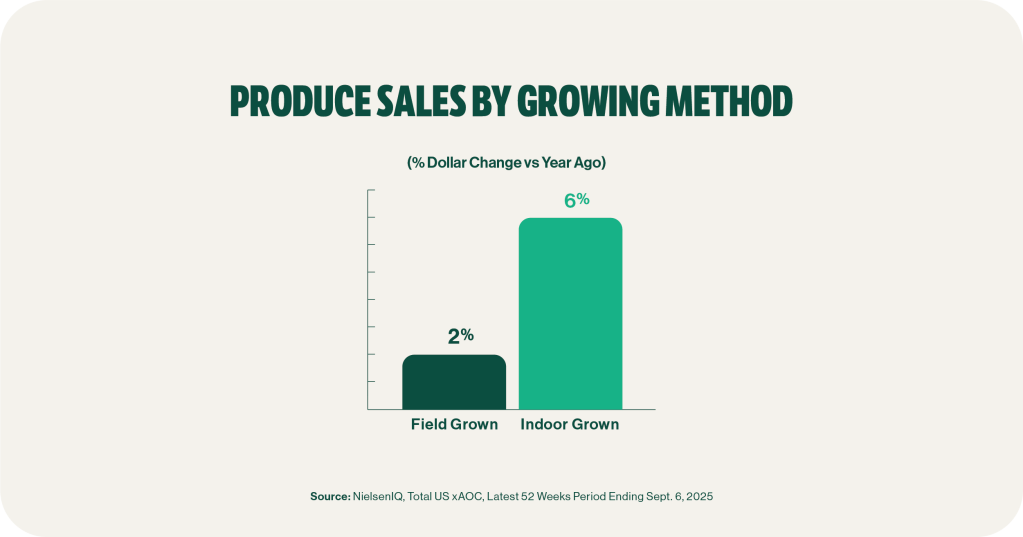
Controlled environment agriculture refers to indoor farming methods that manage variables like light, humidity, temperature and pests. It includes hydroponic farming, vertical farming and high-tech greenhouses — the latter is the kind that Cox Farms operates to cultivate a reliable supply of fresh food year-round. With this trend in mind — as well as the growing unpredictability of traditional farming methods — Cox Farms sees controlled agriculture as the future of fresh food.
There’s an opportunity for forward-thinking retailers to become the go-to destination for this kind of produce: providing shoppers with the fresh, tasty fruits and vegetables they crave, while also benefiting from the high yield and consistent supply that greenhouse agriculture provides. But there are barriers in consumers’ path to purchase and loyalty, such as misunderstandings around terminology, a lack of category education and an incomplete shopping experience.
Cox Farms — the largest greenhouse operator in North America, with powerhouse brands like Mucci Farms and BrightFarms — is committed to helping retailers overcome shopping barriers and to harness the promise of greenhouse-grown to drive increased traffic and larger basket size. Armed with agricultural expertise and proprietary research, we have identified key barriers to shopper adoption and loyalty so that greenhouse-grown gems in the produce department are hidden no more.
What’s in a name?
The multiple innovations within indoor farming offer variety for shoppers…as well as confusion. Consumers like produce that’s grown in controlled environments. But they’re not always able to easily identify it or even know what to call it.
To see which of controlled environment agriculture’s many names resonates most, among other questions, Cox Farms partnered with CPG focused consulting and research firm Seurat Group on a quantitative study Greenhouse-Grown Shopper Trends, Engagement and Segmentation that sampled over 2,400 produce shoppers. The winning name? “Greenhouse-grown,” at 51%.
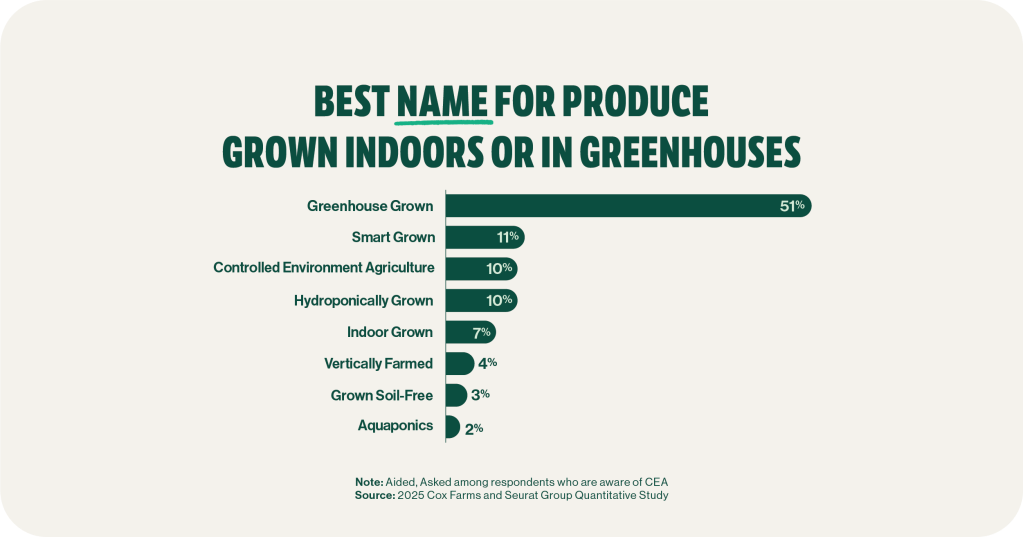
Moreover, the Cox Farms and Seurat Group research study revealed that the phrase “greenhouse-grown” is meaningful, carrying multiple positive associations, from the innovation in the technology to the clean, fresh, quality of the products.
Greenhouse-grown fits into a broader trend toward healthy eating. Consumers are prioritizing their health with food choices, with 3 in 4 saying they are trying to eat healthier and 1 in 2 saying they are eating more fresh foods now than in the year prior (Seurat Group, 2025). As they browse produce departments and seek out fresh, convenient and clean food, it’s imperative that growers and retailers message “greenhouse-grown” to help shoppers understand, embrace and advocate for the category.
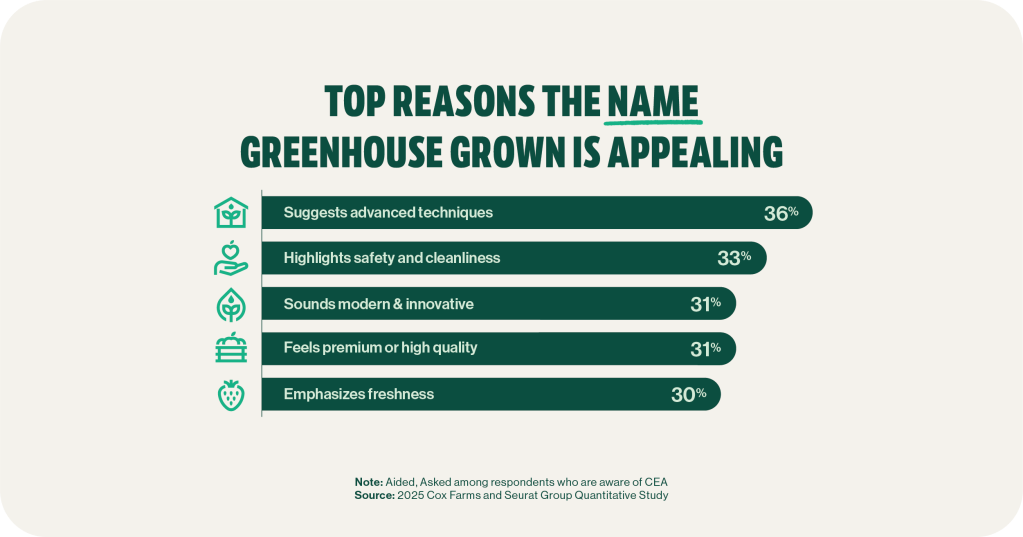
Comparing apples-to-apples (or peppers-to-peppers?)
Crystallizing the term “greenhouse-grown” for produce grown in greenhouses is a significant step toward empowering shoppers to choose specific retailers, increase purchase frequency and build deeper produce baskets.
“A lack of understanding of what greenhouse-grown is (and isn’t) is one of the biggest contributors toward indifference in a busy category.”
But the fact is, if consumers don’t grasp the multiple benefits of the category, they won’t recognize the product’s value, look for it or buy it. And a lack of understanding of what greenhouse-grown is (and isn’t) is one of the biggest contributors toward indifference in a busy category.
Here at Cox Farms, we’re helping retailers cut through noise and communicate the positive attributes of greenhouse-grown produce, such as sustainability, product quality, health and safety, accessible freshness and convenience.
The Cox Farms and Seurat Group research reveals that early adopters for greenhouse-grown produce are centered on health and climate: consumers coming from organics who seek pesticide-free, clean produce and consumers prioritizing sustainability who avoid products that contribute to climate change.
However, across all consumers surveyed in the Cox Farms and Seurat Group study, visual appeal and great taste stood out as the top attributes of CEA produce. And when shoppers are informed of the benefits of greenhouse-grown produce relative to other options, Cox Farms believes they are primed to be drawn toward the freshness, crunch and great flavor, again and again.
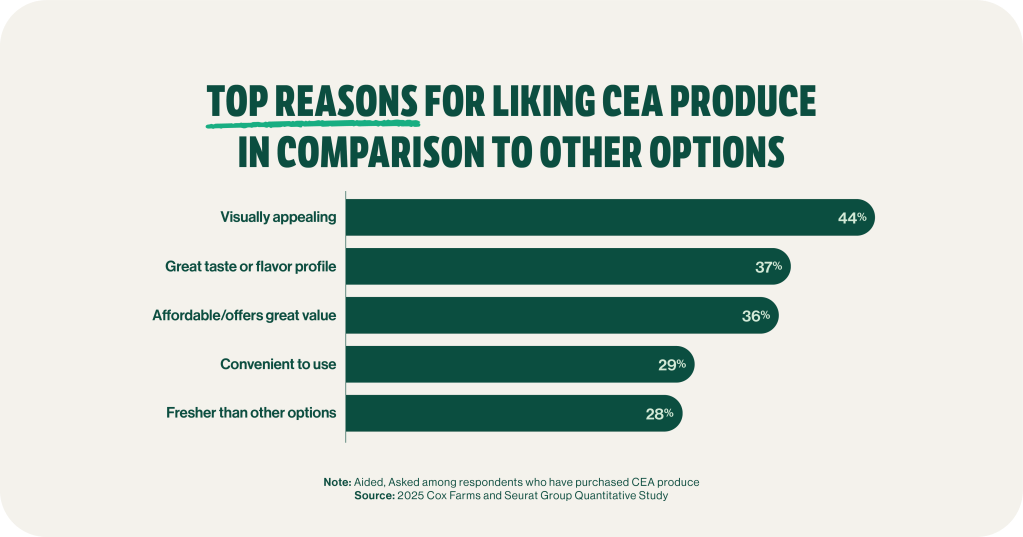
“Excuse me, where can I find the greenhouse-grown lettuce?”
The shopping experience, increasingly across multiple channels and stages of the purchase journey, can offer so much more for shoppers to make informed decisions.
Merchandising greenhouse-grown methods and benefits educates consumers on aspects they care about, like where their food comes from, how it’s grown and our freshness guarantee.
“Tactics like differentiated shelving, aisle redesign, eye-catching visuals and simple educational facts can help retailers disrupt the status quo.”
Retail reinvention benefits consumers, retailers and brands, but it requires a strategic planning approach to distinguish greenhouse-grown produce and guide shoppers to purchase and re-purchase. Tactics like differentiated shelving, aisle redesign, eye-catching visuals and simple educational facts can help retailers disrupt the status quo (Food Industry Association, 2025).
Cox Farms brand — BrightFarms — recently partnered with a leading retailer to use large and prominent signage to carve out a distinct greenhouse-grown section within their refrigerated produce section. The pilot resulted in a 10% increase in sales for that section in comparison to other sections of produce (NielsenIQ, Total Packaged Salad ex Microgreens incl. Kits, Latest Four Week Period Ending Jan. 15, 2025).
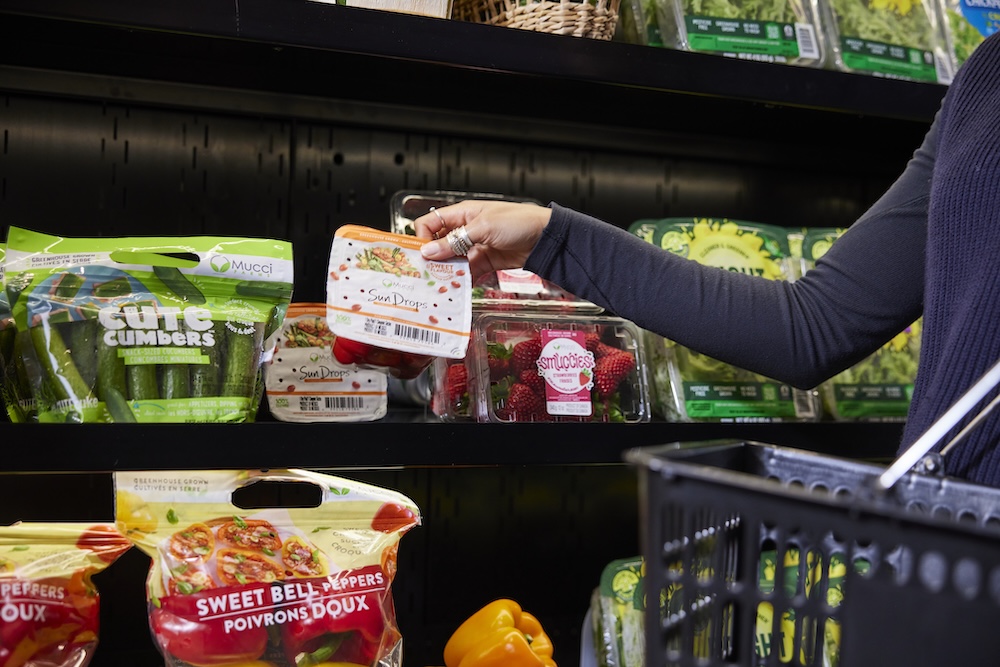
Investing in an optimized shopping experience can yield significant returns and foster renewed product loyalty. Leveraging in-store and online channels — as well as resources from Cox Farms — retailers can help shoppers easily identify and enjoy the greenhouse-grown value equation.
Cox Farms’ vision: increasing availability and access
The path for greenhouse agriculture is a positive one. Shoppers favor greenhouse-grown produce, finding it to be appealing on shelf, fresh longer at home and full of flavor on the table. Retailers agree greenhouse-grown is resilient against the forces of climate and seasonal dips.
With clear and relevant messaging and a strategic approach to retail reinvention, retailers have a golden opportunity to unearth the controlled environment agriculture gems in their aisles, driving interest, purchase and loyalty. Cox Farms is here to help make it happen.
Ready to discover our greenhouse-grown offerings?
Sources
NielsenIQ (NIQ) data.
2025 Cox Farms and Seurat Group proprietary quantitative study (N = 2,443), Greenhouse-Grown Shopper Trends, Engagement and Segmentation.
2025 Food Industry Association “Power of Produce” presentation, presented at the Southeast Produce Council (SEPC) Southern Exposure Conference, March 6–8.



